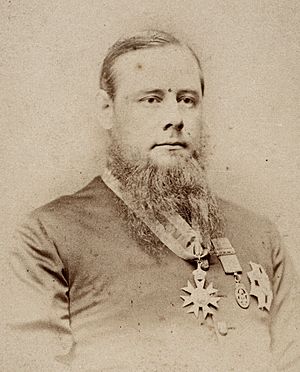George Frederic Verdon facts for kids
Quick facts for kids
George Frederic Verdon
|
|
|---|---|

Sir George Verdon, politician and banker, 1870-1879, by Newman, late Montagu Scott
|
|
| Monarch | Victoria |
| Personal details | |
| Born | 27 January 1834 Lancashire, England |
| Died | 13 August 1896 Victoria (Australia) |
| Nationality | British subject |
| Profession | Statesman |
Sir George Frederic Verdon was an important Australian politician and public figure. He was elected to the Victorian Parliament in 1859. He also managed a big bank in Melbourne. Later, he became the president of the Public Library, Museums, and National Gallery of Victoria in 1883.
Contents
Early Life and Career
Sir George Frederic Verdon was born in Bury, Lancashire, England, in 1834. His father was Reverend Edward Verdon. George went to school at Rossall School. In 1851, when he was 17, he moved to Melbourne, Australia.
When he first arrived in Australia, he worked for a company called Grice Sumner and Company. After that, he started his own business in Williamstown. This was the beginning of his public life.
Starting in Local Government
Verdon became a member of the local council in Williamstown. He was even the chairman of a meeting for many local council leaders. In 1858, he wrote a small book about how local governments in Victoria could work better in the future.
Political Journey
In 1859, George Verdon was elected to the Victorian Parliament. He represented the area of Williamstown. This was a big step in his political career.
Becoming Treasurer
In November 1860, Verdon joined the government led by Richard Heales. He became the Treasurer, which means he was in charge of the colony's money. He left this job in November 1861. However, in June 1863, he became Treasurer again. This time, he worked for the government led by James McCulloch. He stayed in this important role until May 1868.
Helping Victoria's Defences
In 1866, while Parliament was not meeting, Verdon went to England. His mission was to talk to the English government about protecting Victoria. He was very successful! He managed to get £100,000 to help pay for a new warship called the Cerberus. Another ship, the Nelson, was given to Victoria to be used for training.
Verdon also helped Victoria get a loan for big public projects. He also got approval to open a branch of the Royal Mint in Melbourne. This meant Victoria could make its own coins.
Representing Victoria in London
After he returned from England, Verdon suggested that Victoria should have a representative in London. This person would speak for the colony's interests. In 1868, the job of "agent-general" was created. George Verdon was chosen for this important role for four years.
He made a great impression in London. For his work, he received special honours. In 1866, he was made a Companion of the Bath. In 1872, he was given the title K.C.M.G., which meant he became Sir George Verdon. He was also chosen as a member of the Royal Society in 1870, which is a group of important scientists.
When he finished his job as agent-general, he took a new position. He became the colonial inspector and general manager of the English Scottish and Australian Chartered Bank in Melbourne.
Interests and Contributions
Sir George Verdon was interested in many things beyond politics and banking. He loved science, art, and literature.
Supporting Science and Art
When he was a young man, he volunteered at the Melbourne observatory. Later, as Treasurer, he made sure the observatory had the right equipment. He also collected many art objects.
In 1872, he became a trustee of the Public Library, Museums, and National Gallery of Victoria. This meant he helped manage these important cultural places. He became vice-president in 1880 and then president in 1883. He held this position until he passed away. He cared a lot about the different collections in these institutions.
Alton House Estate
In 1874, Verdon bought a large piece of land near the top of Mount Macedon. This land was originally set aside for the Governor's country house. He named his property Alton, after Alton Tower in England. He bought more land nearby to make his property even bigger. He then designed and built Alton House, a large and grand mansion with beautiful gardens.

